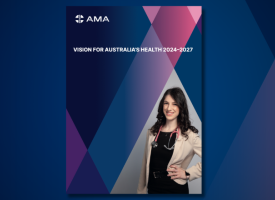AMA Tasmania calls for tax reform to help fund essential health services
AMA Tasmania notes the health budget provides for new investment to pay for election promises, but not much more for existing services that are struggling to deal with growing demand pressures.

Health services are not immune from cuts as the Department of Health will have to find $134.9 million in savings across its services over the next three years.
Worryingly, there is only a 1.7% increase in recurrent funding from this financial year to the next. That is well below inflation and will mean there are more cuts on top of the efficiency dividends to health coming.
We can't afford cuts to any part of the health system when it is already struggling to meet demand.
While some improvement in patient flow is occurring in our hospitals, ambulance ramping continues, patients are still spending too long in emergency departments, diagnostic services are overloaded, outpatients are over booked, and elective surgical procedures are being cancelled.
Health needs significantly more resources to build the new infrastructure it requires, develop new models of care, and fund the staffing involved in running the services within them.
The time has come for tax reform to help fund the services Tasmanians need and expect.
While pleased the government has honoured its commitment not to tax health services through the introduction of payroll tax on your local general practice, we are disappointed this budget does not have any significant changes to increase revenue.
We understand raising revenue is politically difficult; that's why the AMA in Tasmania is calling for politicians to set politics aside and support broader tax reforms.
AMA Tasmania agrees with Saul Eslake’s call for a more comprehensive discussion on how to fund essential services like healthcare sustainably, and that ensures everyone contributes fairly. Healthcare must be funded to meet demands, not at below CPI growth, let alone below health CPI growth.
This is a conversation that all Tasmanians need to be open to having with their political leaders.
These changes could lead to a more efficient and equitable healthcare system, and the AMA Tasmania stands ready to work with the current government to make the necessary changes.
Because frankly, right now, we are not doing enough, and patients are suffering as a result.
Even though the Tasmanian government invests 32% of its annual budget into healthcare, and over $3 billion annually, it is not enough.
With Tasmania's most vulnerable population - our older demographic, patients with chronic disease, low income, poor health literacy, and those without any capacity to explore private health care options – there is always more to do.
The problem is that everything in health comes at a great cost. The result is that investment is often in piecemeal packages linked to political promises and election cycles but not necessarily aligned to meet today's needs or the future.
To meet the healthcare demands of Tasmania, we need the healthcare workforce and the leaders to drive innovation, as well as the medical equipment, electronic medical records, IT support, and infrastructure around Tasmania necessary to deliver patient care.
That's why the AMA has called for major health projects to be delivered over the next ten years- by 2035, not a thirty underfunded masterplan.
We must create subacute, non-acute, and aged care beds so patients can be discharged from our three large acute care hospitals. This will free up those beds so patients can be transferred from emergency departments and have their surgeries without being cancelled.
This noticeable struggle to keep up with necessary public healthcare infrastructure development in Tasmania is further compounded by the collapse of private healthcare infrastructure developments such as the co-located private hospital in Launceston and the closure of the St Helens Hospital in Hobart.
A strong private system is an asset to the public system. For this reason, we welcome the government's investment in beds at the Launceston Hub.
The $649.6m in this year’s budget in hospital and health infrastructure investment projects like the Older Persons Mental Health Facility at St Johns Park and Burnie Hospital Masterplan as well as the continuing investment in ICT is welcome. However, it is not enough.
Other states have built new hospitals that enable innovative healthcare delivery and attract and retain staff in the time we have built one tower of the RHH and spent hundreds of millions of dollars trying to renovate and retrofit expanded services like the ICU and emergency department projects.
The costs that are not quantified and rarely spoken of publicly are the costs to patients and patients' families, the lost workforce productivity, the delays in educational support, and the morbidity and mortality when patients experience delays in being treated in our healthcare system.
Investments in the health workforce are just as crucial.
Tasmania has an unsustainable reliance on locum doctors, agency nurses, and other healthcare workers. We need to rebuild the morale, leadership, pride, and confidence that our healthcare workers have in the government leadership to fund the healthcare system that Tasmanians deserve.
The investment the government has made in the Salaried Medical Practitioners agreement goes a significant way to help us to be a more attractive destination for doctors. We need to see a similar commitment now for our rural and visiting medical practitioners.
It is good to see the $100,000 GP settlement allowance which will see up to eight GPs commit each year to working in general practice in Tasmania for a minimum of five years.
The diagnostic and investigation capacity in the public system needs significant investment and we welcome the $8m set aside to help manage demand pressures in these areas.
Some will argue that with Tasmania's debt problem heading into crisis territory, the state cannot afford to invest more in health infrastructure and services. The problem is that we cannot afford not to, either. >ENDS



